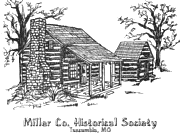|
Monday, May 30, 2011
Progress Notes
Recently, I went to the Miller County Nursing and Rehabilitation Center south of Tuscumbia to visit with Venita Enowski, who moved there a couple of years ago from her home in Olean (photo 01).
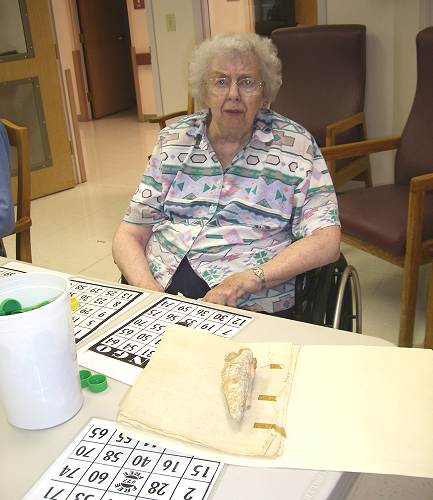
01 Mrs. Enowski
Several years ago Venita had donated to our museum a mastodon tooth found by her father, Eugene Bond on his farm near Olean (photos 02, 03 and 04).

02 Mastodon Tooth
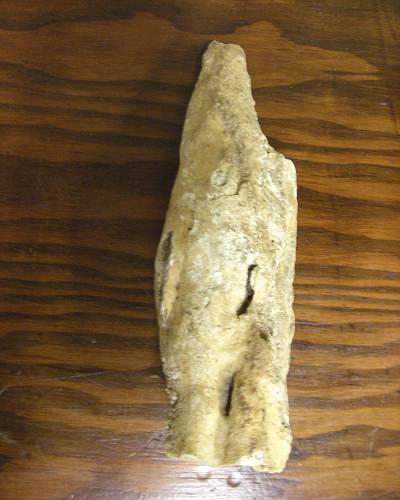
03 Mastodon Tooth
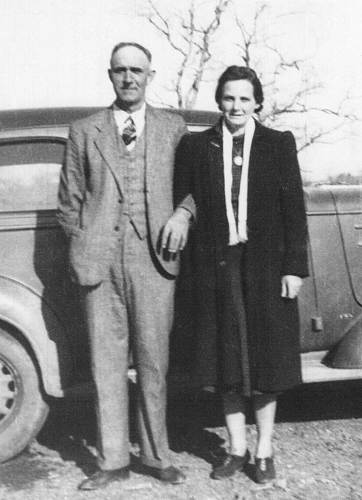
04 Eugene and Maude Bond
The information Venita gave us at the time about the tooth included this brief history:
“The Mastodon tooth was found in a spring six miles east of Olean in 1917 by Eugene L. Bond as he was cleaning out the spring to divert the water for cattle.”
The idea that mastodons roamed Miller County at some time in the long ago prehistoric past intrigued me so I asked Venita to tell me more. But first I wanted to know about her own personal history. Here is a summary of what she told me:
“Tom Miller of near Olean had 14 children. One of them was Maud Miller who married Eugene Bond. Venita Bond was one of Eugene and Maud’s children. Venita married Albert Enoski who originally was from Detroit. After five years in Detroit Venita convinced Albert to move back to her home area in Miller County and Albert learned to become a successful farmer.”
Venita said she is a direct descendent of the original William Miller, the man who was instrumental in the formation our county. Her children include Eugene, Bob, Mary and James who is deceased.
Venita remembers that the family often would go to the Missouri State Museum in Jefferson City to gaze at the Mastodon tooth her father found and donated to the state museum. Quite a few years later the tooth was returned and subsequently donated to the Miller County Museum.
Venita also had donated with the mastodon tooth a manuscript published by the Missouri State Museum of Jefferson City in 1934. Here is a scan of the title page (photo 05):
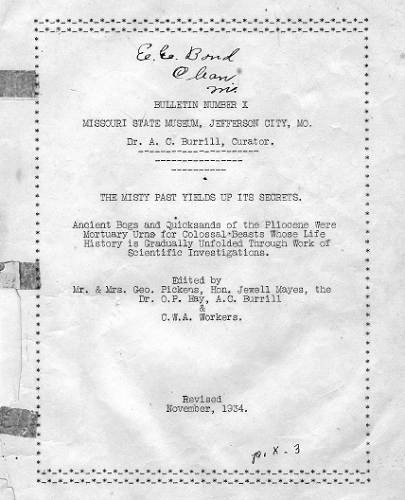
05 Missouri State Museum Bulletin Cover Page
You will notice that the name of Eugene Bond, Venita’s father, is written at the top of the page. On page 3 and 4 of that manuscript is written the following:
“In 1917, Eugene L. Bond, farmer, was cleaning out a spring for his livestock, six miles east of Olean and about two miles south of the Cole County line when he discovered an ancient Mastodon tomb at the head of Brush Creek between the Clark Fork and the Moreau River. Two mastodon teeth from this place have been loaned by Mr. Bond and they are now in the Resources Museum of the State Capitol Building at Jefferson City, Pier D 4A. He dug out these teeth about 17 years ago. Just like Koch’s account of a farmer cleaning out a spring near Bour-Beuse Creek, this farmer started to clean a springy place, having been told by a centenarian lady that cattle had mired in a certain quagmire spot on his newly bought farm. He wished to run the possible water supply to a cattle tank and paid no attention to the many bones he ran into, until he came upon the four teeth, two of which must have been lost since by farmhands. After ten years with rough handling, the chalky roots were mostly broken off while the numerous other bones of this location were broken up in the excavating. Probably they badly disintegrated on exposure to the weather. The continual soaking with under ground water is what must have preserved these bones for so many thousands of years.”
For those readers who want to read more about the mastodons and other ancient species which roamed our county and state during the ice age more than ten thousand years ago I will provide the complete manuscript which the Missouri State Museum gave Eugene in PDF format (photos 06 - 22):
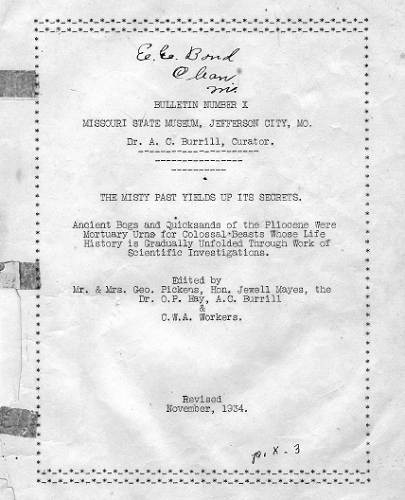
06 Missouri State Museum Bulletin
Click image to read entire document in PDF format
If you want more details about this very interesting Missouri State Park this is the website.
You may have noticed the name of Mr. and Mrs. George Pickens on the title page of the document given Eugene by the Missouri State Museum both of whom are referenced in the body of the narrative of that document (see photo 06 above). George Pickens at the time was head of the State Chamber of Commerce of Missouri (photo 31).
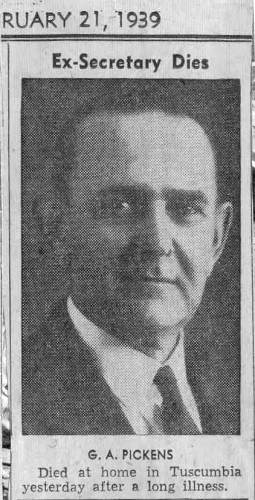
31 George A. Pickens
His wife, Marion B. Pickens, was editor of the “Missouri Magazine,” which was published by the state. It is certainly an interesting coincidence that Mr. and Mrs. Pickens at the time were living in Tuscumbia, Missouri! Mrs. Pickens had selected the old Goodrich home on top of the hill east of the school in which to live because she admired the tremendous view of the Osage River and River valley it affords (photos 32 and 33).
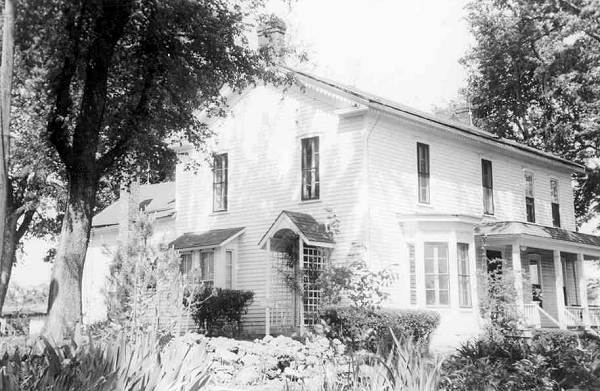
32 Goodrich Pickens House

33 View of River Valley from Goodrich Pickens Home
Mrs. Pickens had an interesting commentary regarding her introduction to Tuscumbia which was recorded in the book “Ozark Superstitions” by Vance Randolph which I will copy here:
Ozark Superstitions
COPYRIGHT 1947 BY COLUMBIA UNIVERSITY PRESS
p. 808
Vance Randolph
Mrs. Marion B. Pickens of Jefferson City, Missouri, editor
of the Missouri Magazine, wrote me (Oct. 1, 1935) of her experience shortly after buying a country home on the Osage River, near Tuscumbia, Missouri:
"The new place is a beautifully located farm house," she said. "We planned to move some native cedars into groupings and had great difficulty in finding someone to do the work because moving cedar trees was known to bring untoward happenings, nearly always a death to the immediate family.
And these Tuscumbians cited actual cases to prove the rule. We finally found a native who was willing to risk the welfare of his family, but he had worked on the big roads out in the valley and had acquired a certain bravado or recklessness in tempting the powers that be. This is a bona fide experience.”
Now I don’t know exactly which Tuscumbians then were afraid of cedar trees but that was a long time ago. However, some Tuscumbia natives remember the Pickens’ and, in fact, during my childhood, the old house was known as the Pickens’ home because Mrs. Pickens lived there until the mid to late 1940’s. The home originally was built by Isaac Goodrich. Here is what Peggy Hake wrote in her biography of Isaac:
Taken from the biography of Isaac Goodrich
by Peggy Hake
In 1900, Isaac and Rebecca had been married 55 years and were living in or near Tuscumbia. The late Homer C. Wright of Tuscumbia told me at one time that Judge Goodrich's house sat on the land where the Tuscumbia Clinic (today the law offices of Kerry Rowden) is sitting. It was a stately, two-story home overlooking the Osage River that flowed in a northeasterly direction through Tuscumbia. The Goodrichs' were a prominent family of Equality Township in the late 19th century. When Isaac bought a fine, new buggy in June 1881, it was newsworthy! The news item in the local newspaper stated he had paid $130 for his buggy and it was shipped to Tuscumbia via the riverboat, "Phil E. Chapell." Isaac died in 1911 at the age of 88 years. His wife, Rebecca, lived for two years longer, dying at the age of 91 years in 1913. They are both at rest in the Tuscumbia town cemetery.
After Isaac died one of his daughters, Edith Goodrich Beckner lived there for many years. She sold the old house and quite a lot of surrounding acreage to George Pickens in the early 1930’s. George sold much of the Goodrich property. This was an extensive holding of land which encompassed all the land along Highway 52 north to where is now located the north city limits; and to the east to the intersection of Highway 52 and 17. You can read more about that as well as the Goodrich family also at this previous Progress Notes.
George Pickens died in 1939 from the residua of injuries suffered in a fall. You can read a summary of his career and life in this obituary published at the time of his death:
Miller County Autogram
February 23, 1939
George Pickens Dies at Tuscumbia
Former Head of State Chamber of Commerce; Was Well Known by Eldon Business Men
George A. Pickens, well known by Eldon business men and a resident of Tuscumbia for the past few years, died at his home there Monday following a long illness.
Mr. Pickens spoke at meetings of the Eldon Chamber of Commerce several times while he was secretary of the State Chamber of Commerce. He was a man greatly interested in the business progress of the towns of Central Missouri and in promoting information about the resources of the state. During the time he served the state as secretary of the Chamber of Commerce, he was editor of the Missouri Magazine, to which Mrs. Pickens was a regular contributor of interesting articles about Missouri.
During Mr. Pickens’ visits about the state he took a liking to the scenery about Tuscumbia and the view from what is known as the Goodrich residence on the hill near the courthouse. He purchased the property from Mrs. Beckner, one of the Goodrich daughters, and surviving member of the pioneer family. The property was improved and a water system installed which furnished the home and other nearby residences. During the improvement of the home, Mr. Pickens fell from the roof and was injured, making it necessary for him to retire from active service, and causing physical complications from which he never recovered.
Mrs. Pickens, two sons, Vern Pickens of Kansas City, and Paul of Marshall; and two stepdaughters, Mrs. Harry Sheinberg and Mrs. Virgil Riek of Jefferson City, are the surviving members of the family.
The funeral was held at Jefferson City Wednesday and burial was made in the Riverview Cemetery there.
Mrs. Pickens lived in the old house for several more years before selling it to Dr. Marshall Humphreys in 1948 who had a medical office there for several years (photo 35).

35 Dr. Marshall Humphreys
In 1953 Dr. Humphreys built a new hospital adjacent to the Pickens house where he practiced until his death in 1972. You can read more about him at this previous Progress Notes.
A few weeks ago (Thursday, April 28) Wallace Vernon in his weekly column in the Eldon Advertiser reported that Dick Dolby had sent him a photo of the house which was present at the site of the current Post Office before the Post Office was built at First and Oak Street in 1940 (photos 36 and 37).
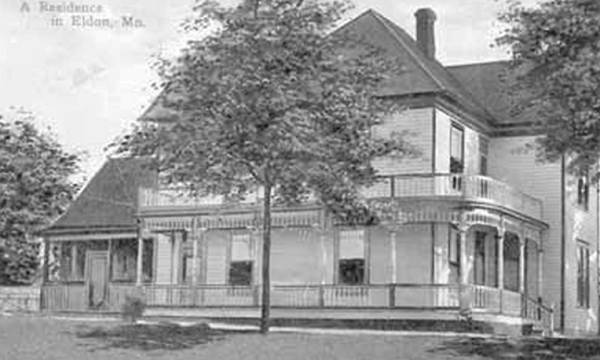
36 THE J. SNYDER RESIDENCE, pictured above, was located at the corner of First and
Oak Streets, the site selected for the present day Post Office in downtown Eldon.
The new postal facility was completed in 1940.
Picture post card photo courtesy Dick Dolby

37 Eldon Post Office
Here is what Wallace (photo 38) wrote:
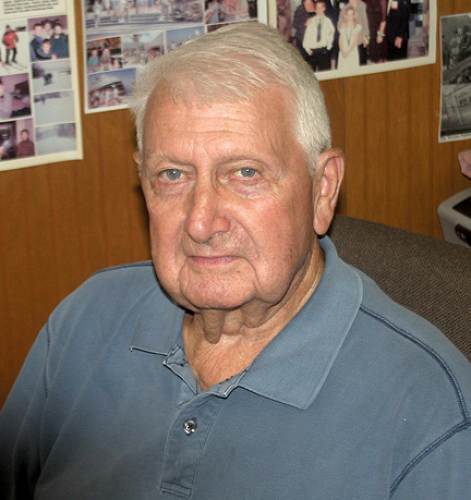
38 Wallace Vernon
THE EX PUB CAN’T BE – sure that every word of his weekly effort is read, but the last sentence of last week’s column brought quick results.
His final query was “Anyone recall what structure was on that corner (where the present post office building is located) before, or was it an empty lot?”
Well let me tell you, within hours after that newspaper reached subscribers, EP not only had an answer but a picture and more information as well.
That very corner was occupied by the stately and substantial residence of the J. Snyder family, one of those mentioned as submitting the site selection for the new postal facility.
Furthermore, Ex Pub learned that N. E. Harvey, another mentioned in the site selection process, was owner of a small house located just south of the corner residence which was likely included in the parcel.
That’s probably about all one would need to know about what previously occupied the site of Eldon’s present postal facility.
So, question answered, Bill.
Thanks Dick Dolby for opening up his scrapbook to solve the mystery!
I went over to Wallace’s Vernon Publishing Company and found a short article in the Autogram about the day the old post office moved to the new one:
Miller County Autogram Sentinel
July 30, 1981
Eldon Postal Staff 1940
Here is the 17 member staff, including substitutes and star route carriers, serving Eldon 41 years ago when the post office was located at 103 S. Maple Street, now site of the Eldon Shoe Store (photo 39).

39 Old Eldon Post Office - 1940
Click image for larger view
From left are Jack Ulrey, substitute clerk-carrier; Ralph Manning, city’s south route carrier; Floyd Loving, city’s north route carrier; John Shepherd, Rural Route 1 carrier; E.C. Davenport, Route 1 substitute carrier; Louis Vernon, Route 2 substitute carrier; L.A. Rusk, Route 2 carrier; Fred Whitlock, route 3 carrier; Roy Cecil Manning, substitute on Tuscumbia Star Route; Howard L. Stephens, postmaster; Chester Vernon, Route 3 substitute carrier; Mrs. A.G. Neville, post office clerk: Wade Humphrey, Tuscumbia Star Route carrier, Ford Vaughan, post office clerk; John Newell, Camdenton Star Route carrier; Tom bunch, post office clerk; and Emmett Dunlap, rocky Mount Star Route carrier.
This picture appeared in the Advertiser May 9, 1940, following a cornerstone laying ceremony on May 3, 1940 for Eldon’s new $70,000 post office at First and Oak Streets, the present Post Office.
The Eldon Post office today serves more than 10,000 people and has 19 postal employees, including substitutes, and two star route carriers. In 1940, Eldon had three rural routes, three star routes, and two city routes; in 1981 it had five rural routes, two star routes (Tuscumbia and Rocky Mount) and three city routes.
Since this article was written in 1981 the data in the paragraph above about the number of people served and the number of postal employees probably is wrong. Also, the Eldon Shoe Store no longer is at the old site. However, the way buildings change or are removed it is interesting to review what used to be in their locations.
Sometimes buildings are abandoned when the business moves. After the grand old Rock Island Train Station was torn down in 1958 a small replacement building was built which through the years has deteriorated. Here is a photo of the original station when it was in operation (photo 40):
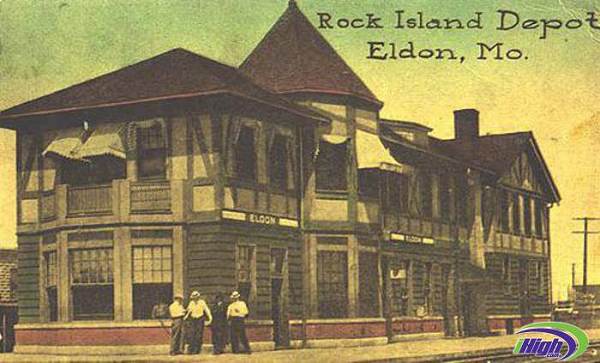
40 Rock Island Station - 1904
And here are some photos of the way the replacement building for the old Station has deteriorated over the years since 1979 when the Rock Island no longer came through Eldon (photos 41 - 45):
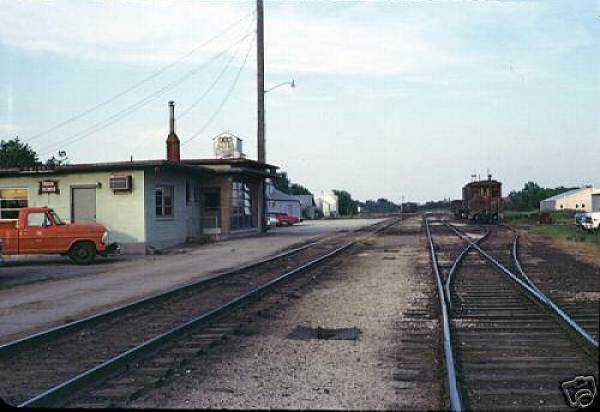
41 Rock Island Station - 1973

42 Rock Island Station (South Side) - 1980
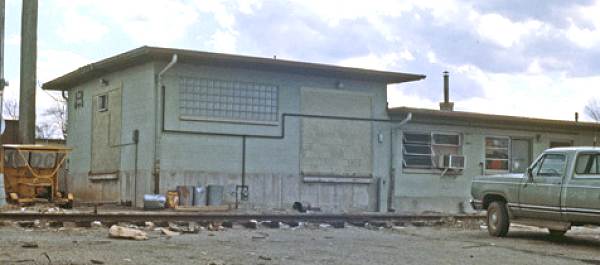
43 Rock Island Station (North Side) - 1980

44 Rock Island Station - 1998

45 Rock Island Station - 2009
An article in the Miller County Autogram Sentinel published soon after the Old Rock Island Station was torn down records some interesting information about the construction of the Rock Island Railroad in the very early 1900’s:
The Miller County Autogram
(clipping does not give date; but was written soon after the Rock Island Depot was removed in 1958)
Recalls Days When Eldon Depot Built
One Eldon resident who can recall construction of the depot here is Jim Bullard, retired Rock Island conductor and railroad historian, who describes his recollections in the following article:
The old Rock Island depot at Eldon that was recently torn down, brings back to many, memories of other days when many of us were hoping that it would be built to house the various railroad offices that were housed in box cars spurred out east of where the depot now stands.
When seven of us railroad men from as many different parts of the country climbed off that little passenger train that brought us from St. Louis on March 17, 1904, we were looking for work. Engineers George Smith, Stockwell and Ohmart; Brakemen Art Guthrie, E.J. Wassesheir, Slug Ryan and myself. All hired out but Ryan. Too much mud; he hunted up his old friend, U.G. Callahan, tapped him for two bucks and went back to St. Louis.
W.C. Morse, superintendent of construction, had offices on the 10th floor of the Frisco building in St. Louis. W.C. Hollister, trainmaster, had his office in a box car; his clerk was H.Dreyfuss; W.F. Fuller was chief dispatcher and his office was in a box car. Trick dispatchers, Walter Johnson, Charley Fowler, and Ford had another box car; Division Engineer Ralph Budd also rated a box car office. His clerk was Jesse Riddle. Budd was really the busy man on the new line. All the top brass were calling for the St. Louis-Kansas City and Colorado to hit Kansas City and get in on the World’s Fair passenger business.
There were other box cars for freight and company supplies. Master Mechanic Gossett and Roundhouse Foreman Harrington had a little office in the roundhouse that stood a short ways south of the depot and we had a big “wye” down below the east yard to turn engines and cars on. Everything was hustle and plenty of mud. They had a big hole dug out with horse drawn scrapers, and ready to build the depot.
A.J. Gorg of Union, Mo., had contracts to build depots and section houses along the line. Ben Inman, brick man from California, Mo., had contract on all the brick work, flues and chimneys; Clark Vanolsdoll drilled the wells along the line; Charley Blackburn and another man handled the drilling, and when they got done at one station, some work train would pick up the flat car that they loaded drill and the old steam engine on and take it to the next station.
The two box cars that played a very important part in our life on the rail about his time, were the cook car where the cooks put in a 24 hour shift, or rather two 12 hour shifts, so the waiter could take our orders out to the dining car, wide open day and night with a bill of fare that varied little from day to day…ham and eggs, bacon and eggs, with side dish of beans, price 2 bits, and a refill on your coffee which, by the way, got weaker as the day wore on. A long table was in the center of the dining box car, long benches on each side, tin plates, tin cups, but when you were hungry it did not matter too much.
Vol Simpson was section boss; Smith Doughtry, gang foreman of 75 men working just west of town, his son, Johnny, was a brakeman, and his son in law, Henry Nowack, later a fireman, the old time gandy dancer, who played his colorful part.
Every passenger train out of St. Louis brought a bunch of them. Pay days were a month apart, and when the tired track man wanted a little fling at life, he just quit, spent his few dollars, went on to the next labor camp, gave another name and went to work. They had their “jungle camp” down at the east yard.
There were fires going day and night, and old pails by the fire to make coffee in. Scullin and Francis with all their forces could not have built the Colorado without the gandy dancer.
I went on a steam shovel job at Versailles, March 21, 1904, braking for Bev Johnson. We worked the day shift. Dave Holder and his brakies worked nights and slept in the box car caboose in daytime, so we worked without a caboose. Later on we moved the shovel east of Barnett and used the dirt to fill out that long curve across the Moreau. We got that job wound up and cut the shovel out and tied up at Eldon 11 p.m. May 6, 1904.
After we tied up that night and were enjoying our “ham and” in the diner, Bev asked us how we would like to go with him on the new local freight that would start the freight going through to Windsor. Bev was a great fellow to work with; we knew it would be a tough job unloading all that freight, when the line opened for freight all the way to Windsor, but we said “O.K.,Bev.”
At 7 Sunday morning, May 8, we got things going on Local Wet Number 121, engine 112, Engineer John Stearns, Fireman George Phauff, and Bev Johnson, conductor, Chester Fuller and myself, brakies. Switched the Eldon yard, worked to Windsor, switched a couple of hours and tied up. Next a.m. switched some more, worked local to Eldon, switched the yard, and tied up. No switch engine at Eldon. Matt Stith was walking up and helped do switching and we stayed on that job all summer.
But when the freight was opened up to Windsor, thing picked up, and here came those bright varnished cars carrying the load of passengers all bent on one thing…St. Louis and the Great World’s Fair. On the start it was a long crooked journey out of K.C. via Frisco to Clinton, Mo., then from Clinton to Windsor via the M.K. & T. down the Big Wye and on to the home road, the Colrado, to good ole St. Louis. Later track was in shape to handle direct out of Kansas City and some days there would be three sections of those long, sleek cars, Pullman, diners, and with the power we had at that time it was quite a problem. The St. Louis Line 10 Spot would take 10 pullmans up that long grade from the Gasconade River to Belle, the longest 11 miles on the Colorado, but some engines would have to doublehead with that kind of a train.
The new depot at Eldon was completed in June. Big Bill King was agent. He had been dispatcher on the old line at Union, later agent at Belle, a big man and a regular power house on work. Later, we got a new superintendent, T.H. Beacom, and he brought his brother in law, E.C. Ryan, as trainmaster, and since that there has been a long line of officials come and go; same applies to the thousands of train and engineers and other employees.
Many millions of dollars have flown through the offices in this old depot and will continue through the new modern building, wages, taxes and for railroad supplies. Thousands of Eldon kids received their education and went forth to take their places in this busy world, because Dad stuck to his fob through thick and thin on the Colorado, and many a kid has waited in that old depot for his first ride behind the great iron horse of childhood dreams.
To many it will just be another gaunt, haunting, outmoded building torn down. To those of us closely associated with the old building, it is the passing of a good old friend.
Here are a couple of photographs copied from the above article (photos 46 and 47):
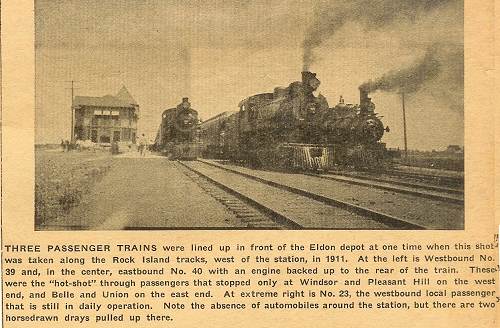
46 Eldon Depot
Click image for larger view

47 Roundhouse
Click image for larger view
Charles Carrender, mentioned in photo 47 above, was the grandfather of Gary Carrender, one of our Miller County Historical Society board members (photo 48).
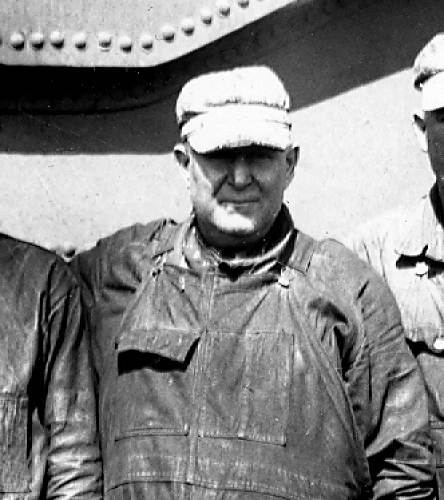
48 Charles Carrender
Another article published in the Eldon Advertiser in 1967 records the story of the end of the Rock Island Station in Eugene:
In a Nutshell
Clipping of unknown author
Published 1967 Eldon Advertiser
Another of the old time railroad depots will soon disappear. The latest of these old structures scheduled for razing is the Eugene depot on the Rock Island line between Eldon and St. Louis (photo 49).

49 Eugene Rock Island Depot
The exact age of the depot had not been determined as we went to press this week. Apparently it was built about the same time as the other depot buildings along the Rock Island, around 1903-1904, after the first train reached Eldon on October 22, 1903.
The depot at Eugene has been closed since October 14, when the railroad business conducted there was shifted to the freight agent’s office at Eldon. Bert Ford was agent at Eugene when the depot closed down; he had been there six years.
Ford, whose father retired in 1955 as agent at Eugene, is now station agent at Durham, Kansas, on the Rock Island’s main line between Kansas City and Tucumcari, New Mexico. He returns to his home at Eugene for the weekends.
His father, J.S. Ford, of 316 North Mill Street, retired from the Rock Island with 50 years of service, the last 18 as Eugene agent.
Like most other passenger depots which have seen little use in the past decade, the building at Eugene, located on a sharp curve in the tracks, appears somewhat lonesome, with its peeling paint, broken windows and rotting gutters. On the rear of the building is a stenciled reminder that the building was last painted in December, 1950.
Four years after that paint job, passenger service through Eugene ended on the Rock Island. The railroad was permitted to shorten its Kansas City- Belle run to Kansas City-Eldon. And in April of 1959, the last passenger train ran between Kansas City and Eldon.
The Eugene depot, as did the other original depot buildings along the line, once played important roles in the communities they served, with as many as six passenger trains daily. In September of 1904, area residents could get a round trip on the Rock Island to the World’s Fair in St. Louis on certain days of the week for $4.80.
The empty waiting room for passengers in the Eugene depot is boarded off from the agent’s office no doubt to conserve heat. The agent’s office itself is virtually empty now except for a wooden desk, a fuel oil heating stove and the large manual levers which control the semaphore signal just outside the agent’s windows.
The Rock Island is not accepting bids on the Eugene depot, and its removal appears relatively certain in the near future, almost nine years after the old depot at Eldon was razed, in early 1958. Another Eldon depot, the Missouri Pacific building, is also scheduled for demolition.
With the old depot goes some of the history of the towns they once served with pride. The depots themselves were doomed largely by the demise of the railroad passenger business.
One of the longest careers with the Rock Island Railroad was that of A.B. Stanley. His departure was the subject of an article in the Eldon Advertiser in April of 1940:
Eldon Advertiser
April 18, 1940
Engineer A.B. Stanley Retires After 38 Years
Brought Passenger Train No. 24 From Kansas City to Eldon On Final Run Monday (photo 50)
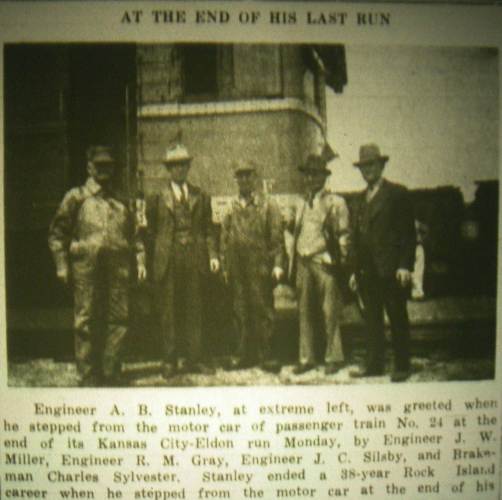
50 A.B. Stanley Retires
Click image for larger view
Engineer A.B. Stanley brought passenger train No. 24 to Eldon from Kansas City on his final run Monday. When he stepped from the cab of the motor car he was ending a 38 year record of service to the Rock Island, as he is now retired.
A.B. Stanley, at the time of his retirement, was the oldest engine man in service in the St. Louis District of the Missouri Kansas Division. He was employed as fireman in April 1902, and in June was promoted to engineer.
At the end of his last run he was met by men of the W.E. Morse Division 611, B. of L.E. and other friends who congratulated him upon a long, successful career as a railroad engineer. He and Mrs. Stanley departed for a vacation in Florida and from there plan to go to Hawaii.
You can read more about the history of the railroad trains of Miller County at these two previous Progress Notes:
- April 7, 2008
- October 26, 2009
I suppose the theme of the several stories written above is that many things have their time to go and be replaced depending upon the economy or advances and improvements which change older ways of doing things.
Our museum farm display received a lot of attention at our recent opening day event last May 14. One of the things of great interest is our collection of unusual antique farm tools (that is, unusual to us). We have them on display for one reason to ask for help in identifying them. For example, I doubt many people could identify the item in this photo (photo 51):
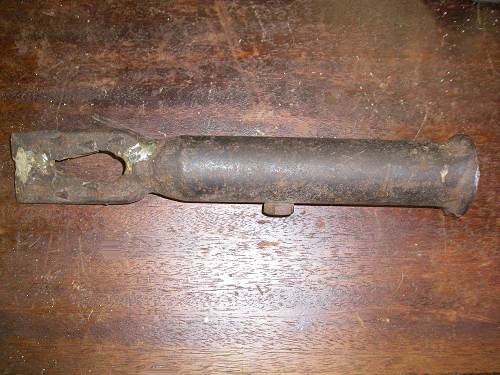
51 Explosive Log Splitter
However, it is an explosive log splitter. The blade end is driven into the log and the body of the splitter has gun powder placed in it which can be ignited after the splitter is driven part way into the log.
The next photo is of a thumb corn sheller (photo 52).
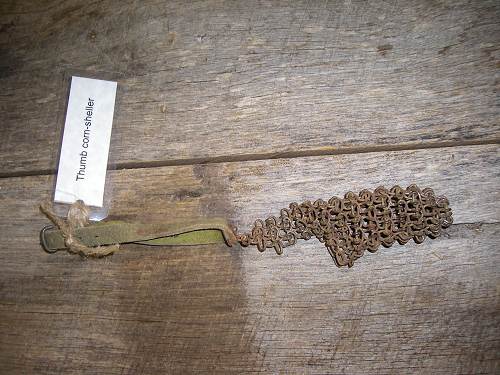
52 Thumb Corn Sheller
Although that is what it is called, I’m wasn't sure at all how to use it. However, our internet expert David Statler, who puts together the layout of Progress Notes for the website, gave me the following information:
"I did a quick search and saw a Thumb Corn Sheller on eBay. At the site they had some other pictures of how it fits on your hand and what it was used for. Basically it was used to shell off the corn from the cob to give to chickens, ducks, etc."
Here is a photo from the website which shows how the sheller was placed on the hand (photo 52a).

52a Corn Sheller on Hand
The next tool again looks as if it would require some practice and training to use (photo 53).

53 Corn Shucker
It is a corn shucker--used for leverage to break the ear of corn off the main plant.
Once in a while if you get out and about to the many weekend events going on around the county you sometimes find your picture in the paper. In the Advertiser edition of May 26 I was surprised to see myself in a photo taken by Tammy Witherspoon of the Advertiser (photo 54).
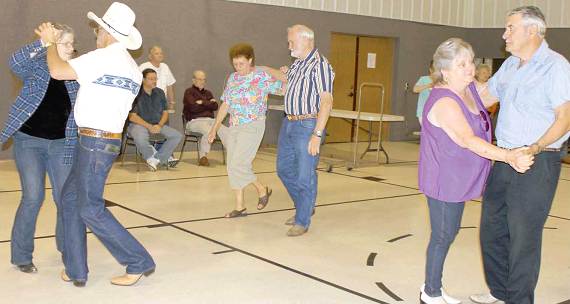 54 Dancing to the Country Music
54 Dancing to the Country Music
Folks took to the dance floor during the set of Scottie and the Swinging Hoitties during the
Genuine Country Music Association Country Music Jamboree to benefit the
Wounded Warrior Project Sunday, May 22 at the Eldon Community Center.
(Photo by Tammy Witherspoon)
The event was the Genuine Country Music Association Country Music Jamboree to benefit the Wounded Warrior Project held Sunday, May 22 at the Eldon Community Center. Sitting on my right in the photo is Jim Phinney, former Lee Mace’s Ozark Opry performer, who also entertained later that day with his own group. Jim has continued his association with the Ozark Opry by assisting Joyce Mace, Lee’s wife, in the years since Lee’s death in 1985 and even now after the Opry closed a few years ago. Joyce Mace sponsored and funded the Lee Mace’s Ozark Opry display at our museum and Jim was onsite at our museum at the time to ensure it was set up appropriately.
Last week the Vernon Publishing Company featured our museum on the cover as well as a couple of inside pages of a special edition titled “Guide To Southeastern Miller County… Life On The Osage River” (photo 55).
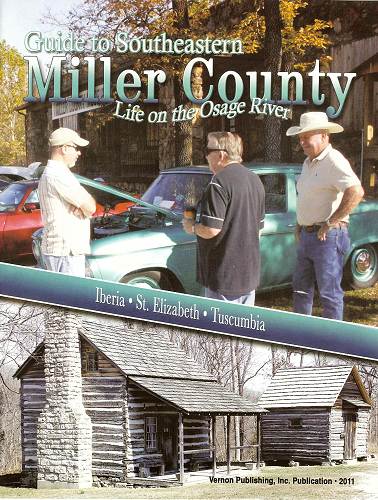
55 Cover Page Inside was a photo of our board members (photo 56) and a photo of the museum (photo 57).
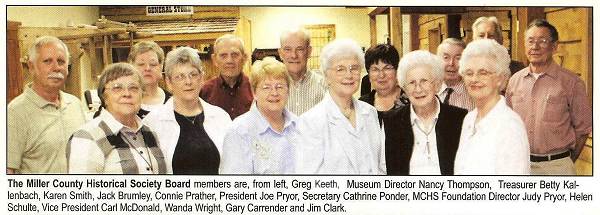
56 Board Members
Click image for larger view
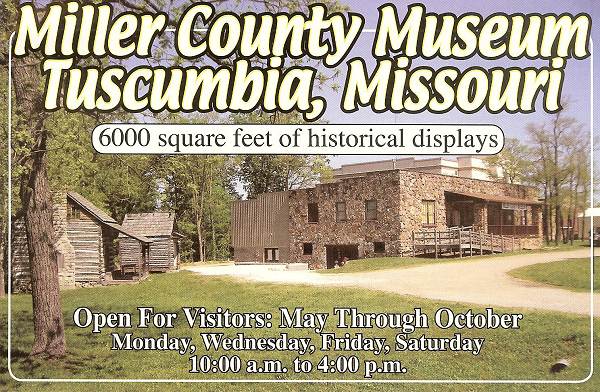
57 Museum We appreciate very much the exposure Ginny Duffield and the Vernon Publishing Company provide for our museum and the Miller County Historical Society.
That’s all for this week.
 Joe Pryor
Previous article links are in a dropdown menu at the top of all of the pages.
|
